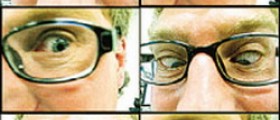
Narrow angle glaucoma, also known as closed angle glaucoma, is an eye condition characterized by acute attacks of eye pain which result from a sudden increase in intraocular pressure. This is actually the second most common type of glaucoma.The Onset of Attacks and Symptoms
Inside the eye special organs produce watery fluid. It circulates inside the eye and is drained via special canals located in the angle formed by the cornea and the iris. This angle can be narrowed from the birth (congenital) and in such case it may additionally narrow causing quite detrimental consequences. The fluid stops being drained and it accumulates inside the eyeball triggering an acute attack of narrow angle glaucoma.
Until an attack occurs a person does not complain about any symptom. However, once the closure takes place and fluid accumulates inside the eyeball, a person starts to feel sudden and severe eye pain, may feel nauseated and even vomit. The affected eye is generally red, vision is blurred and patients commonly report to see halos around the lights.
The Severity and Potential Triggers
The attack of narrow angle glaucoma represents a medical emergency and requires prompt medical assistance. If left untreated, it can cause severe damage to the optic nerve and complete vision loss in the affected eye.
The attack of narrow angle glaucoma may be triggered by medications and other factors which cause further narrowing of the angle between the cornea and the iris. This particularly refers to pseudoephedrine, phenylephrine and Neo-synephrine. Furthermore, such patients must avoid antihistamines (chlorpheniramine, Diphenhydramine, Benadryl etc) as well as Detrol, a drug used in patients suffering from overactive bladder. And finally, corticosteroids such as cortisone, Hydrocortisone and Prednisone also increase intraocular pressure and, therefore, should be avoided as well.
Narrow Angle Glaucoma Treatment
Treatment for narrow angle glaucoma is surgical. Such patients are treated with a laser. During the procedure the doctor creates a small hole in the very angle between the cornea and the iris and by doing so allows the eye fluid to be properly drained. The surgery is not painful and the results are excellent.
It is best to perform the procedure as soon as the diagnosis is set. The surgery is inevitable for all people who are born with narrow angle glaucoma and in whom the attacks frequently repeat. This way potential complications such as permanent vision loss can be successfully prevented.
In rare occasions a laser-made opening may close and the surgery can be easily repeated providing with desirable results.

















Your thoughts on this
Loading...